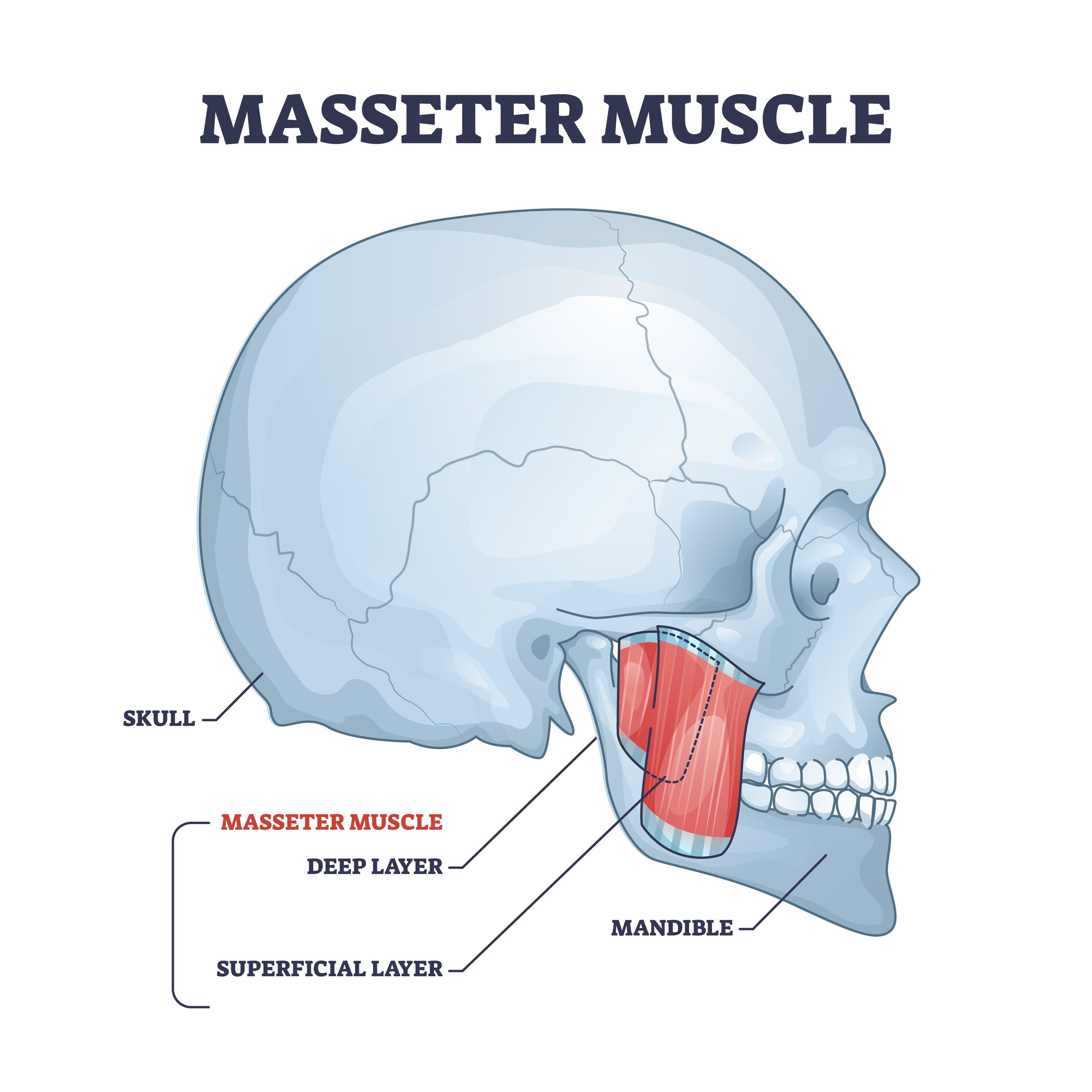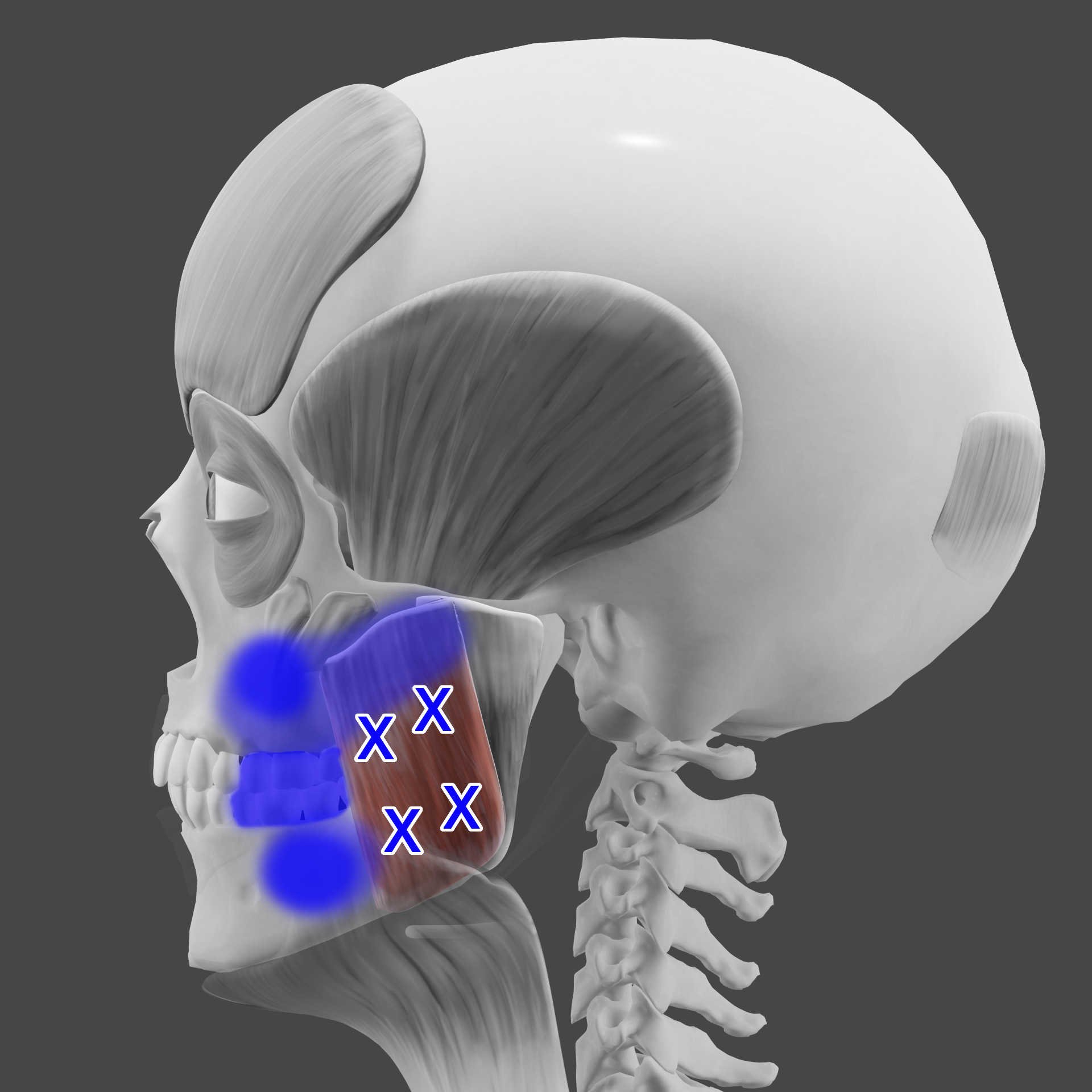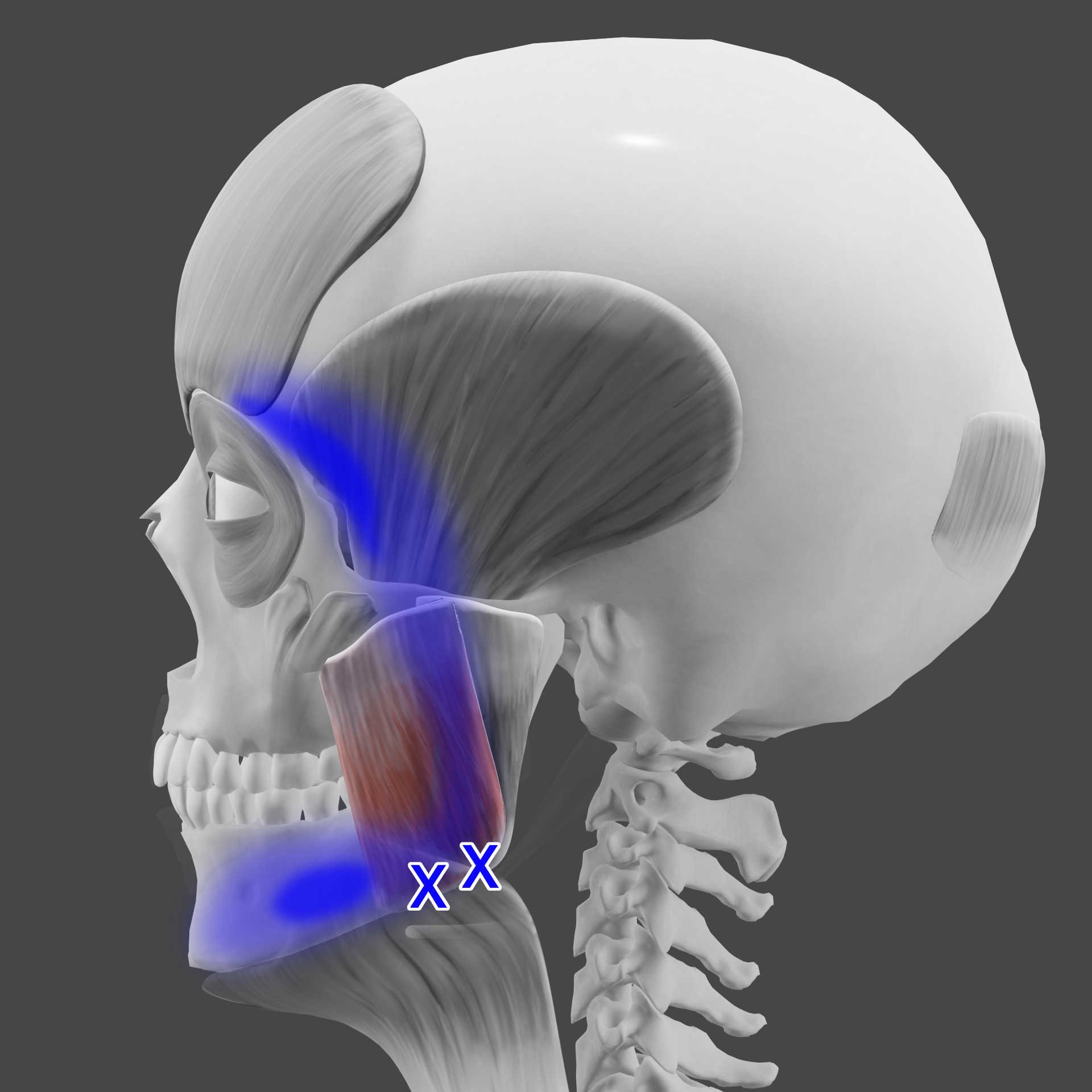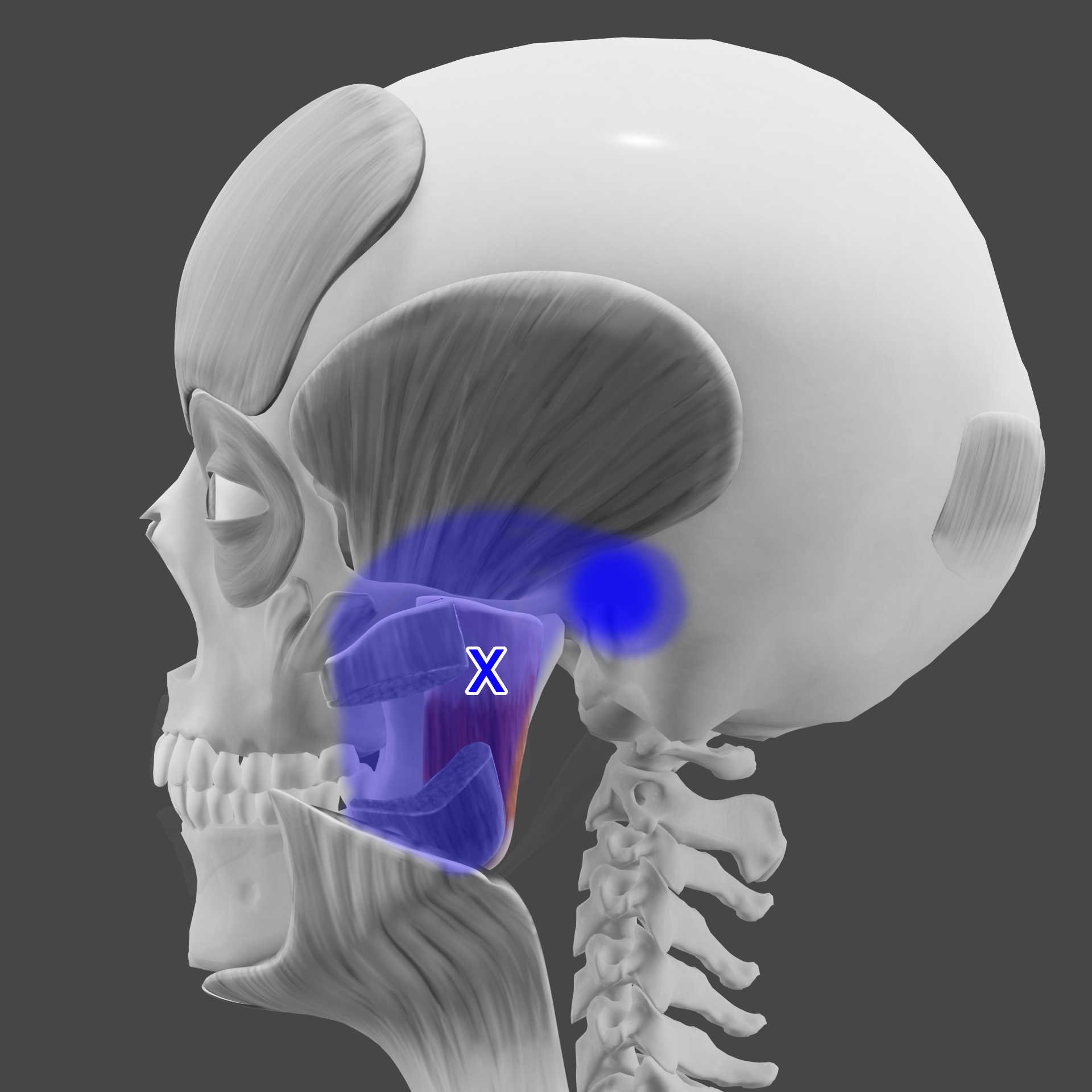Masseter Muscle Pain Treatment
Masseter muscle
Effective Strategies for Alleviating Masseter Muscle Pain
Masseter muscle pain can be a distressing experience, disrupting your ability to chew, talk, and even smile with ease. You’re likely seeking direct answers to what triggers this pain and how you can alleviate it quickly. This article offers clear, actionable solutions for identifying the causes of masseter muscle pain and a range of effective relief strategies tailored to get you back to comfortable jaw movements promptly.
Acupuncture and dry needling can effectively treat trigger points in the masseter muscle, but there may be other sources of masseter pain. Read more to learn about this muscle as well as other treatments and self-care.
Key Takeaways
Masseter muscle pain stems from tension that may be due to emotional stress, physical factors like malocclusion and bruxism, regular habits like constant chewing, or the activation of trigger points within the muscle.
Effective management of masseter muscle pain includes identifying and alleviating trigger points through massage and posture adjustments, and understanding the interconnectedness with neck muscles to address referred pain.
Persistent masseter pain may require multidisciplinary treatment approaches combining various techniques, including professional therapies like post-isometric relaxation and myofascial release, as well as home exercises and behavioral modifications.
Understanding Masseter Muscle Pain
The masseter muscle, an essential player in our daily jaw movements, consists of three distinct layers - the superficial masseter muscle, the deep, and the coronoid part, each originating from different areas of the zygomatic bone and arch and attaching to the jaw bone, or mandible. The deep part of the masseter elevates the mandible, while the coronoid part is suggested to stabilize it by elevating and retracting the coronoid process. But when tension builds in this muscle, it can manifest as pain in the jaw, ear, and head, impacting jaw movement and making opening the jaw both painful and difficult.
Several factors contribute to the tension experienced in the masseter muscle. These include:
Mental and emotional stress, which can lead to unconscious tension
Physical factors such as malocclusion, bruxism, and poor posture
Regular habits such as constant chewing or other acute biting actions
These factors can strain the masseter muscle and potentially lead to temporomandibular joint (TMJ) syndrome. Additionally, they can activate trigger points in the masseter muscle, adding to its tension.
The Role of the Masseter in Jaw Movement
Our ability to chew, speak, and perform other intricate jaw motions hinges on the functioning of the masseter muscle. As the most prominent masticatory muscle, the masseter is pivotal for mandibular elevation against the maxilla. Its superficial fibers primarily aid in elevating the mandible, while the deep posterior fibers contribute to mandible retrusion.
Beyond its main function, the masseter also slightly aids in the protraction of the mandible and in lateral movements, critical for more intricate jaw motions.
Common Causes of Masseter Tension
The triggers for masseter tension are often found in our daily routines and habits. Mental and emotional stress can lead to unconscious muscle tension which persists even after the stressful event has passed. Physical factors such as malocclusion, bruxism, and poor posture can strain the masseter muscle and potentially lead to TMJ syndrome.
Furthermore, habits such as constant chewing or other acute biting actions can activate trigger points in the masseter muscle, adding to its tension. These trigger points, which are small areas of muscle cramps and contractions, can cause significant tension and pain in the masseter muscle when activated.
Masseter Pain Treatment
Aims for the release of trigger points to reduce pain and restore jaw function.
Avoids forceful stretching if TMJ internal derangement is suspected.
May involve various modalities like manual therapy, acupuncture, dry needling, or injections.
Masseter pain treatment should be gentle yet effective, respecting the delicate structures of the TMJ and seeking to alleviate the root causes of discomfort.
Other Treatments for Masseter Pain
Masseter Botox Before and After
Botulinum toxin, commonly known as Botox, is generally considered a safe and effective treatment for both therapeutic and cosmetic purposes, with its use in cosmetic procedures being particularly prevalent globally. The treatment is associated with two main types of adverse events: transient and benign incidents that are localized and self-limiting, and more serious complications which can result from the systemic spread of the toxin, potentially leading to botulism-like symptoms.
While most side effects such as pain, swelling, and mild bruising at the injection site are temporary and resolve without intervention, serious complications, although rare, include systemic effects like muscle weakness, dysphagia, and respiratory issues. Precautionary measures and a thorough understanding of the patient's medical history can help mitigate risks. Additionally, the correct application technique and appropriate dosage are crucial to avoid misplacement and minimize potential systemic absorption of the toxin.
Botox injections can reduce muscle hypertonicity and pain.
Before-and-after results typically show improved jaw opening and decreased pain.
Must be administered by a healthcare professional with expertise in facial anatomy.
Botox treatment in the masseter muscle has shown promising results for patients with chronic masseter hypertonicity, improving function and aesthetics.
One study found that reducing masseter muscle stiffness with botox may result in a compensatory increase in stiffness of the temporal muscle. It may be necessary to treat both of these muscles together in cases of TMJ pain but more research needs to be done.
Masseter Botox Gone Wrong
Incorrect administration can lead to adverse effects like asymmetry or unwanted muscle paralysis.
A comprehensive understanding of facial anatomy is essential to avoid complications.
Patients should seek treatment from experienced professionals to minimize risks.
While Botox treatment can be effective for masseter pain, it's not without potential risks, underscoring the importance of choosing a qualified practitioner.
Detecting Trigger Points in the Masseter
Comprehending how trigger points in the masseter muscle present and affect discomfort is vital for its management. These localized knots, or trigger points, can cause discomfort when pressing on the cheek or opening the mouth wide, and a masseter muscle that feels hard or ‘ropy’ upon examination may indicate their presence. These trigger points can impede blood flow to the area, causing irritation and discomfort, increase tension and often produce pain, leading to dysfunction.
It’s also imperative to identify referred pain patterns emanating from these trigger points. Tension-type headaches and headaches mimicking migraines can result from trigger points in different areas of the masseter muscle, including the temple area and over the eyebrow. Similarly, trigger points in the upper and lower parts of the masseter muscle can refer pain to both the maxillary (upper) and mandibular (lower) molars, causing a sensation of toothache that can lead to misdiagnosis. Masseter muscle trigger points can also mimic sinus pain and earaches, leading to misdiagnoses of sinusitis or ear-related conditions.
Additional referred pain symptoms from masseter trigger points include eye pain or blurred vision and unilateral tinnitus.
Recognizing Referred Pain Patterns
Referred pain from masseter muscle trigger points can manifest as:
headaches
toothaches
sinus pain
earaches
eye pain
unilateral tinnitus
These pains often lead to misdiagnoses.
Understanding these referred pain patterns can help in the accurate diagnosis and effective management of masseter muscle pain.
Techniques for Self-Examination
Taking the mystery out of masseter muscle pain begins with learning to self-examine. Palpation of the masseter muscle can reveal discomfort, muscle nodules, or a jump sign, which may indicate trigger points. Self-massage techniques, such as gentle rubbing in small circular motions or applying consistent pressure to release tension, can help locate and alleviate tight spots in the masseter muscle.
It’s also valuable to use a mirror to observe any asymmetries or deviations in jaw movement within the human body, which can indicate potential trigger points and the need for trigger point therapy.
Strategies to Ease Masseter Muscle Pain
When you experience masseter muscle pain, finding immediate relief is of paramount importance. Techniques such as ischemic compression, precise massage strokes, and the pressure-motion technique can provide direct pain relief. However, while massage can be beneficial, it alone may not suffice for severe jaw pain, suggesting the need for additional treatments. Long-term relief often requires addressing the root causes of stress and making positive changes in lifestyle.
Employing massage techniques is one such strategy. Here are some effective methods of self-massage for relieving tension in the masseter muscle:
Gentle rubbing with fingertips or knuckles in small circular motions, applying consistent pressure directly to the masseter trigger points for 5 to 10 seconds to release tension.
Circular massaging of the area to further promote muscle relaxation.
Performing a deep stroking massage from the cheekbone down towards the jawline to elongate the masseter muscle fibers and provide tightness relief.
Combining pressure application on trigger points with stretching, such as by holding the pressure while slowly opening the mouth, can improve the effectiveness of self-massage.
Massage Techniques for Relief
Massage techniques can be a powerful tool to release tension in the masseter muscle. Here are some techniques you can try:
Self-massage: Gently rub the muscle with your fingertips or knuckles in small circular motions.
Applying pressure: Apply consistent pressure directly to the masseter trigger points for a few seconds.
Circular massaging: After applying pressure, further alleviate tension by massaging the area in small circular motions.
These techniques can help relieve pain and release tension in the masseter muscle.
Deep stroking massage from the cheekbone down towards the jawline can elongate the masseter muscle fibers, providing relief from tightness. Combining pressure application on trigger points with stretching can improve the effectiveness of self-massage.
Postural Adjustments for Long-Term Comfort
Apart from massage, achieving long-term relief from masseter muscle pain often necessitates lifestyle modifications, such as postural adjustments. Good posture for the head, neck, and tongue is crucial in preventing ongoing strain on the masseter muscle. Maintaining good body posture can aid in the long-term comfort and health of the masseter muscle.
Additionally, avoiding abusive oral habits, such as exhaustive chewing, teeth clenching, and teeth grinding, can help decrease unnecessary strain on the masseter muscle.
Adjacent Muscles and Their Impact on Masseter Pain
Within the intricate network of our body’s musculature, the masseter doesn’t operate independently. Muscles adjacent to it, such as the medial pterygoid muscles and neck muscles, can have a significant impact on masseter pain. Understanding the role of these muscles and their interaction with the masseter is crucial for comprehensive pain management.
The interconnectedness of the masseter with the neck muscles can contribute to discomfort in the jaw. Tension in the neck can directly contribute to discomfort in the masseter muscles. Moreover, pain in the masseter muscle can manifest as tension headaches and create tension in the neck and shoulders due to anatomical connections. Rheumatic pain in the jaw may escalate muscle tension around the joint, potentially leading to the formation of trigger points as the muscle pain and tension persist.
Specific exercises like neck extension, shoulder shrugs, neck rotation, and neck flexion, when done correctly and repeatedly, can ease tension in both the neck and masseter muscles.
Interconnectedness with Neck Muscles
The interconnectedness of the masseter with the neck muscles plays a significant role in masseter discomfort. Tension in the neck can directly contribute to discomfort in the masseter muscles. Pain in the masseter muscle can create tension in the neck and shoulders due to anatomical connections.
Rheumatic pain in the jaw can escalate muscle tension around the joint, potentially leading to the formation of trigger points. Specific exercises that can ease tension in both the neck and masseter muscles include:
Neck extension
Shoulder shrugs
Neck rotation
Neck flexion
Cross-Muscle Trigger Point Activation
The phenomenon of cross-muscle trigger point activation can further complicate masseter muscle pain. Satellite trigger points, which are newly activated trigger points in other muscles as a result of referred pain from key trigger points, can develop in muscles such as the ipsilateral temporalis and medial pterygoid, and in the contralateral masseter muscle, contributing to complex patterns of pain.
Jaw Relaxation Techniques to Practice at Home
In addition to seeking professional treatments, several home-based jaw relaxation techniques can help lessen masseter muscle pain.
Physical therapy exercises for TMJ relief include:
Temporal and masseter muscle stretches
Relaxed jaw exercise
Chin tuck exercise
Resisted mouth movements
These techniques can alleviate symptoms by loosening the tight jaw muscles, helping to lessen pain and realign the jaw joint.
Meanwhile, behavioral modifications can be an effective strategy for preventing jaw clenching. Here are some tips to help reduce jaw clenching:
Increase awareness of jaw positioning throughout the day and set reminders to relax the jaw.
Practice evening relaxation techniques such as meditation and restorative yoga to promote overall relaxation and decrease teeth clenching at night.
Incorporate stress-reducing activities like gentle stretching or short walks throughout the day to lower stress levels and minimize the tendency to clench the jaw.
Daily Exercises for Jaw Tension Release
Physical therapy exercises can play a crucial role in alleviating masseter muscle pain. Some exercises that can help include:
Temporal and masseter muscle stretches
The relaxed jaw exercise
The chin tuck exercise
Resisted mouth movements like resisted opening and closing
Goldfish exercises
These exercises promote relaxation while helping to maintain proper jaw alignment, strengthen the jaw, reduce inflammation, and prevent further damage.
Regularly practicing these exercises can provide short-term TMJ relief by relaxing, stretching, and strengthening jaw muscles, contributing to overall jaw relaxation.
You should figure out the cause of your masseter or TMJ pain before trying these exercises.
Behavioral Modifications to Prevent Clenching
Along with physical exercises, making behavioral changes can play a significant role in preventing jaw clenching and easing masseter muscle pain. Becoming aware of jaw positioning throughout the day and setting reminders to relax the jaw can help reduce habitual daytime clenching. Evening relaxation practices such as meditation and restorative yoga can decrease the incidence of teeth clenching at night by promoting overall relaxation.
Incorporating stress-reducing activities like gentle stretching or short walks throughout the day can lower stress levels and subsequently minimize the tendency to clench the jaw. Therapy, journaling, and engaging in activities that bring joy can serve as effective stress management measures, which can help curb teeth clenching habits. Avoiding stimulants like tobacco and caffeine, as well as alcohol and recreational drugs, is crucial since they can predispose individuals to increased clenching.
Navigating Complex Cases of Masseter Muscle Pain
Masseter pain can frequently signal more complex conditions, like temporomandibular joint dysfunction or temporomandibular joint syndrome. It’s crucial to distinguish between these conditions and masseter pain to ensure appropriate treatment is sought.
For complex cases, adopting a multimodal and multidisciplinary treatment approach that combines various therapeutic techniques can enhance treatment effectiveness. Integrating various health professions skilled in TMJ treatment into a multidisciplinary team can improve clinical outcomes for patients with temporomandibular disorders.
Distinguishing TMJ Syndrome from Masseter Pain
Distinguishing between TMJ syndrome and masseter pain is crucial for effective treatment. TMJ syndrome symptoms include:
TMJ pain
Jaw pain
Aching around or inside the ear
Painful chewing
Clicking jaw while chewing
Lockjaw feeling
Sensitive teeth
Headache
Neck ache
TMJ syndrome can affect up to 15 percent of adults between 20-40 years of age. These symptoms can worsen with activities such as eating hard-to-chew foods and actions that burden the jaw, including yawning, singing, and teeth clenching.
While masseter pain can often be attributed to trigger points in the muscle which refer pain to areas like the ear and over the temporomandibular joint, this can be mistaken for earache or TMJ disorder symptoms.
Collaborative Care Approaches
In managing complex cases of masseter muscle pain, a collaborative care approach can be highly beneficial. A multimodal and multidisciplinary approach to TMJ treatment, encompassing various therapeutic techniques administered simultaneously and in coordination, can increase treatment effectiveness. Integrating various health professions skilled in TMJ treatment into a multidisciplinary team can improve clinical outcomes for patients with temporomandibular disorders.
Summary
In conclusion, masseter muscle pain, while common, should not be overlooked. Understanding the role of the masseter in jaw movement, recognizing the signs of tension and trigger points, and implementing strategies for easing pain can significantly improve quality of life. While self-care strategies can be effective, professional treatments may be necessary in more persistent and complex cases. Implementing a collaborative care approach and navigating the complexities of masseter muscle pain with the guidance of healthcare professionals can enhance the effectiveness of treatment. Remember, your masseter muscle works tirelessly for you every day. It’s worth taking the time to understand it and care for it properly.
Frequently Asked Questions
What are the functions of the masseter muscle?
The masseter muscle functions to elevate the jaw bone, bringing the teeth together in the chewing motion, and also to move the lower jaw forward, bringing the lower front teeth in front of the upper front teeth. This muscle is essential for chewing and closing the jaw.
What are the symptoms of an enlarged masseter?
The symptoms of an enlarged masseter may include a wide, square-shaped face, a strong jawline, difficulty chewing or biting food, jaw clenching, and jaw pain or TMJ. Facial asymmetry, pain, headache, muscle stress, trismus, and intermittent masticatory claudication can also be reported as symptoms. Enlarged masseter symptoms can also involve limitations on mouth opening, swollen cheek, and tension in the region of the hypertrophied muscle.
How do you get knots out of masseter muscle?
You can gently massage the masseter muscle and find the Rest Position with your jaw to release knots, and place 2 to 3 fingers on the muscles below your cheek bones and feel for tightening when clenching teeth.
What does a tight masseter feel like?
A tight masseter might cause discomfort in the form of tension headaches, earaches, toothaches, dizziness, tinnitus, teeth grinding, and temporomandibular joint syndrome (TMJ). These symptoms are often indicative of a tight masseter.
How do you relieve masseter muscle pain?
To relieve masseter muscle pain, you can apply hot packs to increase circulation and relax the muscle, as well as gently massage the muscle to decrease pain and improve flexibility.
Over to you
If you liked this article, please share with friends and family who may be suffering with TMJ or masseter muscle pain.
Sources:
Travell, J. G., Simons, D. G. (1993). Myofascial pain and dysfunction: The trigger point manual. London: Lippincott Williams & Wilkins.
Biel, A., & Dorn, R. (2010). Trail guide to the body: A hands-on guide to locating muscles, bones and more. Boulder, CO: Books of Dicovery.
Janda, Vladimír. “Muscle Function Testing.” (1983).
Corcoran NM, Goldman EM. Anatomy, Head and Neck, Masseter Muscle. [Updated 2023 Jun 5]. In: StatPearls [Internet]. Treasure Island (FL): StatPearls Publishing; 2024 Jan-. Available from: https://www.ncbi.nlm.nih.gov/books/NBK539869/
Shen, Y. F., & Goddard, G. (2007). The short-term effects of acupuncture on myofascial pain patients after clenching. Pain practice : the official journal of World Institute of Pain, 7(3), 256–264. https://doi.org/10.1111/j.1533-2500.2007.00140.x
Fernández-Carnero, J., La Touche, R., Ortega-Santiago, R., Galan-del-Rio, F., Pesquera, J., Ge, H. Y., & Fernández-de-Las-Peñas, C. (2010). Short-term effects of dry needling of active myofascial trigger points in the masseter muscle in patients with temporomandibular disorders. Journal of orofacial pain, 24(1), 106–112.
Mierzwa D, Olchowy C, Olchowy A, Nawrot-Hadzik I, Dąbrowski P, Chobotow S, Grzech-Leśniak K, Kubasiewicz-Ross P, Dominiak M. Botox Therapy for Hypertrophy of the Masseter Muscle Causes a Compensatory Increase of Stiffness of Other Muscles of Masticatory Apparatus. Life (Basel). 2022 Jun 6;12(6):840. doi: 10.3390/life12060840. PMID: 35743871; PMCID: PMC9225551.
Witmanowski H, Błochowiak K. The whole truth about botulinum toxin - a review. Postepy Dermatol Alergol. 2020 Dec;37(6):853-861. doi: 10.5114/ada.2019.82795. Epub 2019 Feb 5. PMID: 33603602; PMCID: PMC7874868.
Disclaimer: This web site is intended for educational and informational purposes only. Reading this website does not constitute providing medical advice or any professional services. This information should not be used for diagnosing or treating any health issue or disease. Those seeking medical advice should consult with a licensed physician. Seek the advice of a medical doctor or other qualified health professional for any medical condition. If you think you have a medical emergency, call 911 or go to the emergency room. No acupuncturist-patient relationship is created by reading this website or using the information. Morningside Acupuncture PLLC and its employees and contributors do not make any express or implied representations with respect to the information on this site or its use.






